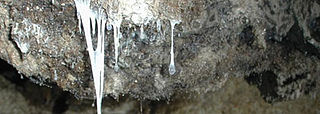
Snottite, also snoticle, is a microbial mat of single-celled extremophilic bacteria which hang from the walls and ceilings of caves and are similar to small stalactites, but have the consistency of nasal mucus. In the Frasassi Caves in Italy, over 70% of cells in Snottite have been identified as Acidithiobacillus thiooxidans, with smaller populations including an archaeon in the uncultivated 'G-plasma' clade of Thermoplasmatales (>15%) and a bacterium in the Acidimicrobiaceae family (>5%).
A biosignature is any substance – such as an element, isotope, molecule, or phenomenon that provides scientific evidence of past or present life. Measurable attributes of life include its complex physical or chemical structures, its use of free energy, and the production of biomass and wastes. A biosignature can provide evidence for living organisms outside the Earth and can be directly or indirectly detected by searching for their unique byproducts.

The Caves of Mars Project was an early 2000s program funded through Phase II by the NASA Institute for Advanced Concepts to assess the best place to situate the research and habitation modules that a human mission to Mars would require. The final report was published in mid 2004.
Zoë is a solar-powered autonomous robot with sensors able to detect microorganisms and map the distribution of life in the Atacama Desert of northern Chile, duplicating tasks that could be used in future exploration of Mars. Zoë is equipped with tools and sensors to search for direct evidence of life beneath the surface of the ground. Zoë significantly aids in research needed to study Mars because it acts as a mobile observer and analyzer of any signs of life in a given location. She collects primary data which will help in understanding conditions present on Mars. This project will verify reliability of autonomous, mobile, and scientifically made robots.
Melissa G. Trainer is an American astrobiologist who in 2004 demonstrated empirically that life could have formed on Earth through the interaction of methane, carbon dioxide and ultraviolet light (sunlight). She is Assistant Chief for Science, Operations, and Strategic Planning in the Planetary Environments Laboratory at NASA's Goddard Space Flight Center.
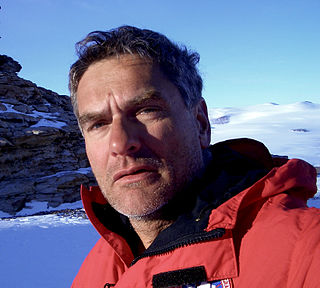
Dr Christopher P. McKay is an American planetary scientist at NASA Ames Research Center, studying planetary atmospheres, astrobiology, and terraforming. McKay majored in physics at Florida Atlantic University, where he also studied mechanical engineering, graduating in 1975, and received his PhD in astrogeophysics from the University of Colorado in 1982.

Zacatón is a thermal water-filled sinkhole belonging to the Zacatón system - a group of unusual karst features located in Aldama Municipality near the Sierra de Tamaulipas in the northeastern state of Tamaulipas, Mexico. It is the deepest known water-filled sinkhole in the world with a total depth of 339 meters (1,112 ft). The 392 meters (1,286 ft) deep Pozzo del Merro is deeper, but its nature as a near-vertical cave or a sinkhole still being debated.

David H. Grinspoon is an American astrobiologist. He is Senior Scientist at the Planetary Science Institute and was the former inaugural Baruch S. Blumberg NASA/Library of Congress Chair in Astrobiology for 2012–2013.

The Phobos monolith is a large rock on the surface of Mars's moon Phobos. It is a boulder about 85 m (279 ft) across and 90 m (300 ft) tall. A monolith is a geological feature consisting of a single massive piece of rock. Monoliths also occur naturally on Earth, but it has been suggested that the Phobos monolith may be a piece of impact ejecta. The puzzling thing is tall rectangular pieces of stone can not be classed as boulders, so there is a question to be asked as to its real origin. The monolith is a bright object near Stickney crater, described as a "building sized" boulder, which casts a prominent shadow. It was discovered by Efrain Palermo, who did extensive surveys of Martian probe imagery, and later confirmed by Lan Fleming, an imaging sub-contractor at NASA Johnson Space Center.
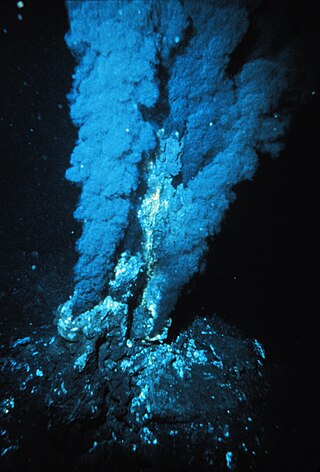
Astrobiology Science and Technology for Exploring Planets (ASTEP) was a program established by NASA to sponsor research projects that advance the technology and techniques used in planetary exploration. The objective was to enable the study of astrobiology and to aid the planning of extraterrestrial exploration missions while prioritizing science, technology, and field campaigns.
Norman Richard Pace Jr. is an American biochemist, and is Distinguished Professor Emeritus of Molecular, Cellular and Developmental Biology at the University of Colorado. He is principal investigator at the Pace lab.
Richard Brice Hoover is a physicist who has authored 33 volumes and 250 papers on astrobiology, extremophiles, diatoms, solar physics, X-ray/EUV optics and meteorites. He holds 11 U.S. patents and was 1992 NASA Inventor of the Year. He was employed at the United States' NASA Marshall Space Flight Center from 1966 to 2012, where he worked on astrophysics and astrobiology. He established the Astrobiology Group there in 1997 and until his retirement in late 2011 he headed their astrobiology research. He conducted research on microbial extremophiles in the Antarctic, microfossils, and chemical biomarkers in precambrian rocks and in carbonaceous chondrite meteorites. Hoover has published claims to have discovered fossilized microorganisms in a collection of select meteorites on multiple occasions.
ExoLance is a low-cost mission concept that could hitch a ride on other missions to Mars in an effort to look for evidence of subsurface life.

Nathalie A. Cabrol is a French American astrobiologist specializing in planetary science. Cabrol studies ancient lakes on Mars, and undertakes high-altitude scientific expeditions in the Central Andes of Chile as the principal investigator of the "High Lakes Project" funded by the NASA Astrobiology Institute (NAI). There, with her team, she documents life's adaptation to extreme environments, the effect of rapid climate change on lake ecosystems and habitats, its geobiological signatures, and relevance to planetary exploration.
Mars habitability analogue environments on Earth are environments that share potentially relevant astrobiological conditions with Mars. These include sites that are analogues of potential subsurface habitats, and deep subsurface habitats.
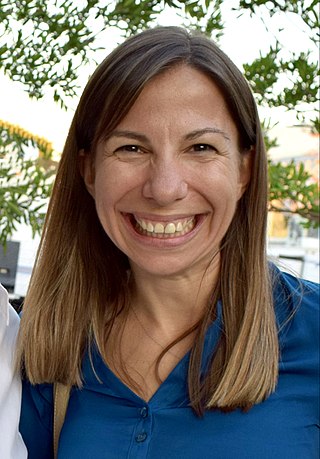
Margarita Marinova is a Bulgarian aeronautical engineer. She is the Senior Mars and Vehicle Systems Development Engineer at SpaceX.
Signs Of LIfe Detector (SOLID) is an analytical instrument under development to detect extraterrestrial life in the form of organic biosignatures obtained from a core drill during planetary exploration.
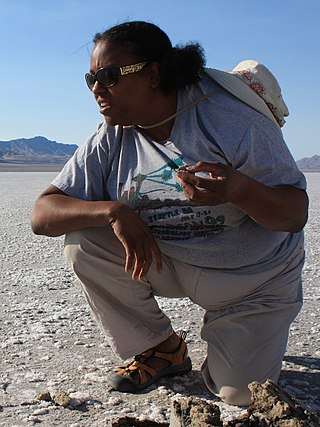
Kennda Lian Lynch is an American astrobiologist and geomicrobiologist who studies polyextremophiles. She has primarily been affiliated with NASA. She identifies environments on Earth with characteristics that may be similar to environments on other planets, and creates models that help identify characteristics that would indicate an environment might host life. Lynch also identifies what biosignatures might look like on other planets. Much of Lynch's research on analog environments has taken place in the Pilot Valley Basin in the Great Salt Desert of northwestern Utah, U.S. Her work in that paleolake basin informed the landing location of NASA's Perseverance Rover mission—at another paleolake basin called Jezero Crater. Jim Greene, Chief Scientist at NASA, called Lynch "a perfect expert to be involved in the Perseverance rover." Helping to select the proper landing site for NASA's first crewed mission to Mars in 2035 is another of Lynch's projects. Lynch has appeared in multiple television series, as well as The New York Times, Nature, Scientific American, and Popular Science. Cell Press designated Lynch one of the most inspiring Black scientists in the United States.
Annette Summers Engel is an American earth scientist who is Donald and Florence Jones Professor of Aqueous Geochemistry at the University of Tennessee. Her research considers how microbes interact with rocks and minerals. She was elected Fellow of the American Association for the Advancement of Science in 2019.
Diana E. Northup is an American microbiologist, speleologist, ecologist, Visiting Professor of Biology, and Professor Emerita of Library Sciences with the University of New Mexico. Her research focuses on the microbial ecology of caves around the world. Dr. Northup is a Fellow of the National Speleological Society and the Cave Research Foundation. She wrote the Wiley textbook Microbial Ecology. She was awarded the National Speleological Society Science Prize in 2013.










